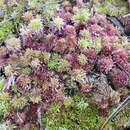Comments
provided by eFloras
Sporophytes are uncommon in
Spagnum tenerum. The sexual condition is uncertain because of past taxonomic confusion with
S. capillifolium (R. E. Andrus 1980).
Sphagnum tenerum is usually described (incorrectly) as having hemiisophyllous stem leaves, and many collections of other species of sect.
Acutifolia with such leaves have been called
S. tenerum. When correctly characterized,
S. tenerum is can be confused only with
S. capillifolium, with which it has only a very small range overlap. Microscopically, besides the otherwise quite different
S. angermanicum,
S. tenerum is the only species of sect.
Acutifolia with large round free pores in most of the branch leaf hyaline cells on their concave surfaces. See also discussion under 71.
S. capillifolium. Sexual condition and spore features were taken from H. A. Crum (1984).
The name Sphagnum evansii Warnstorf has also been used for this taxon.
- license
- cc-by-nc-sa-3.0
- copyright
- Missouri Botanical Garden, 4344 Shaw Boulevard, St. Louis, MO, 63110 USA
Description
provided by eFloras
Plants ± robust, weak-stemmed, and compact, capitulum hemi-spherical, branches in capitulum short and blunt; typically mottled pale yellow-green and purplish red, without metallic sheen when dry. Stems pale yellow-green to pink; superficial cortical cells nearly always aporose. Stem leaves 1.4-1.8 mm, elongate-triangular, lingulate-triangular, hemiisophyllous forms elongate triangular-ovate, 1.4-1.8 mm, apex usually conspicuously toothed, border narrow at base (less than 0.25 width); hyaline cells narrowly rhombic to S-shaped, can be efibrillose and aporose but more commonly fibrillose and porose, 0-1-septate. Branches turgid and terete, leaves, not 5-ranked. Branch fascicles with 2 spreading and 1-2 pendent branches. Branch leaves ovate, 1.1-1.7 mm, slightly concave, straight, apex weakly involute and conspicuously toothed; hyaline cells on the convex surface with round to elliptic pores along the commissures, grading from moderate-sized pores near apex to large pores at leaf base, concave surface with large round pores throughout. Sexual condition uncertain, monoicous or dioicous or possibly both. Spores 22-25 µm, finely roughened.
- license
- cc-by-nc-sa-3.0
- copyright
- Missouri Botanical Garden, 4344 Shaw Boulevard, St. Louis, MO, 63110 USA
Synonym
provided by eFloras
Sphagnum capillaceum var. tenerum (Sullivant) H. A. Crum; S. capillifolium var. tenerum (Sullivant) H. A. Crum; S. tenerum var. virginicum H.A. Crum & L. E. Anderson
- license
- cc-by-nc-sa-3.0
- copyright
- Missouri Botanical Garden, 4344 Shaw Boulevard, St. Louis, MO, 63110 USA
Comprehensive Description
provided by North American Flora
Sphagnum tenerum Sull. & Lesq.; Sull. in A. Gray, Man. ed. 2. 611. 1856.
Sphagnum Evansii Warnst. Hedwigia 47: 99. 1907. Sphagnum Eatonii Warnst. Hedwigia 47: 100. 1907.
Plants compact, often robust, yellowish or whitish, more or less tinged with pink or red, Wood-cylinder yellowish-green to red ; cortical cells of the stem in 2-3 layers, large, thin-walled without fibrils, the outer cells quadrilateral to pentagonal, frequently as wide as long, without pores: stem-leaves very large, triangular-ovate, concave, involute toward the apex, the border narrow above, of 2-3 rows of narrow cells, slightly broadened at the base, the walls of its cells pitted; hyaline cells rhomboidal, 6-8 times as long as wide at the apex, longer toward the base, fibrillose throughout or nearly so, frequently divided, on the inner surface with numerous large rounded pores, 3-5 per cell, on the outer surface with numerous elliptic pores along the commissures, becoming cell-wide in the basal part of the leaf: branches in fascicles of 4 or 5, 2 spreading, their cortical cells in a single layer, without fibrils, the retort-cells well developed, with conspicuous necks: branch-leaves closely imbricate, large, ovate, slightly involute toward the toothed apex, the border entire, of 2-3 rows of narrow cells; hyaline cells fibrillose, narrowly rhomboidal, 8-12 times as long as wide at the base, shorter above to 5-6 times, on the inner surface with small pores in the ends of the cells in the apical part, in the lower side-regions with numerous large rounded pores, up to 7-8 per cell, on the outer surface with narrowly elliptic pores along the commissures, 61 5 per cell : chlorophyl-cells in section very small, narrowly triangular or trapezoidal or almost ellipsoid, exposed on the inner surface, the lumen of similar shape, very small; hyaline cells convex on the iimer surface, up to one-fifth of the diameter of the cell, very strongly convex on the outer surface, mostly one-half of the diameter of the cell or more, without resorption-furrow.
Commonly monoicous. Antheridial branches like the others except as the antheridial leaves are more strongly tinged red, the fibrils of the latter somewhat weakened in the basal hyaline cells. Fruiting branches erect, short; perichaetial leaves relatively small, ovate. abruptly narrowed to an involute point, the apex finally blunt or truncate, with uniform cells throughout or nearly so, the latter narrow, very convex, with pitted walls: capsule brown: spores bright-yellow, 25-30 n in diameter, coarsely roughened.
Type localit-: Raccoon Mountains, Alabama.
Distribution: Newfoundland to Alabama.
- bibliographic citation
- Albert LeRoy Andrews, Elizabeth Gertrude Britton, Julia Titus Emerson. 1961. SPHAGNALES-BRYALES; SPHAGNACEAE; ANDREAEACEAE, ARCHIDIACEAE, BRUCHIACEAE, DITRICHACEAE, BRYOXIPHIACEAE, SELIGERIACEAE. North American flora. vol 15(1). New York Botanical Garden, New York, NY

